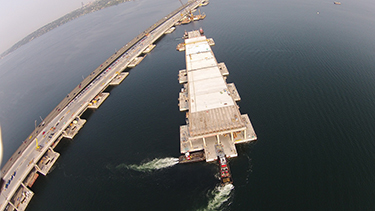|
Subscribe / Renew |
|
|
Contact Us |
|
| ► Subscribe to our Free Weekly Newsletter | |
| home | Welcome, sign in or click here to subscribe. | login |
Construction
| |
 |
April 14, 2016
Building the bridge was an intricate undertaking
Built in 1963, the first Evergreen Point Floating Bridge served as a critical connector for more than 70,000 vehicles moving across Lake Washington each day.
Spanning 7,578 feet, it represented the world’s longest floating bridge, which after 50 years of wear and tear was destined for retirement. As such, the Washington State Department of Transportation enlisted the help of Kiewit/General/Manson (KGM), a joint venture, to build the new state Route 520 floating bridge.
An expanded structure
In many ways, the existing bridge helped influence the approach to construction and design. The old bridge was especially susceptible to closures on windy or stormy days when waves crashed over the edge and spilled onto the roadway. By raising the new bridge 20 feet above water, the roadway is now out of wave range, offering a more reliable transportation corridor.
The SR 520 floating bridge has also been expanded from two to three lanes in each direction, including a high-occupancy vehicle lane, and a separated bicycle and pedestrian path to accommodate the growing demand for alternative transportation options.
Designed and built for a 75-year life span, the bridge also offers the flexibility to accommodate light rail in the future.
Multiple work sites
Constructing the main components of the bridge — which consists of 77 concrete pontoons, 760 columns, 776 panels and more than a mile of roadway — called for intricate planning.
The space constraints at the construction site and its proximity to the old bridge, which remained in service, required the use of multiple locations for KGM operations.
Concrete pontoons, which are buoyant and allow the bridge to float on water, were built at construction sites in Aberdeen and Tacoma. Combined, the sites needed to be large enough to construct the pontoons in three short years. This required about 160,000 cubic yards of concrete, which is about is about 49 times the volume of an Olympic swimming pool.
KGM developed a unique buoyancy system that offered benefits in terms of construction sequencing and schedule. Referred to as the T Pontoon, a steel barge provided the additional the buoyancy to float pontoons out of the production facility, allowing use of the Tacoma facility for pontoon production. The pontoons were delivered to Lake Washington through the Hiram M. Chittenden Locks in Ballard.
The concrete panels, needed to support the bridge, were constructed in Kenmore at an industrial site adjacent to Lake Washington. Crews produced 11 to 12 panels a week, which were barged to the site for the new bridge and installed as the roadway deck.
Working on water
To access the site for the new SR 520 bridge, crews built a work trestle and a flexible-floating island, which provided a driving surface to connect the Medina shore to the floating part of the bridge.
Since there was limited space around the bridge site, KGM built a modular barge with ramps that connected the shore to the work trestle and onto the pontoons where construction operations occur. The modular barge consisted of short barges linked together that was floated in and out of the east navigation channel. The functionality of the modular barge allowed concrete trucks and other vehicles to come and go with ease, while also maintaining access for marine traffic on the lake.
As construction of the bridge progressed from east to west, KGM used an innovative approach to maximize efficiency.
The final three pontoons — referred to as pontoons B, C, and D — were bolted together to create the “BCD Raft.” The raft was temporarily moored adjacent to the east end of the bridge and allowed crews to construct the BCD Raft at the same time as they were building the west end of the bridge. This allowed crews to work on multiple portions of the bridge at the same time and reduced the construction schedule by four months.
End of the old bridge
The new SR 520 floating bridge offers a safe, efficient commute and is designed to accommodate future transportation demands. It also marks the end of an era for the old bridge. After five decades and the passage of millions of vehicles, KGM will begin bridge decommissioning of the old bridge this spring.
The pontoons have been sold and will be removed from Lake Washington through the Ballard Locks. The majority of the remaining components will be dismantled onsite and hauled to concrete-recycling facilities, where most of the materials will be processed for reuse as dry aggregate for new concrete, gravel or asphalt paving projects.
Other Stories:
- How ‘belvederes’ and ‘sentinels’ helped make the bridge look the way it does
- How much do you know about the new 520 bridge?
- WSDOT ‘nerve center’ keeps watch over the bridge
- The floating bridge opening has been a long time coming



